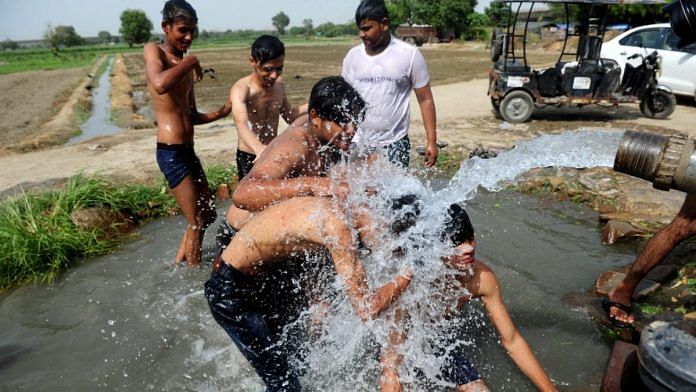New Delhi: The Indian Meteorological Department (IMD) predicted an early monsoon for Delhi, which was that it would hit the national capital by 15 June, as opposed to the regular day of 27 June. Both dates have now passed, and Delhi has experienced nothing more than the odd shower.
Instead, the national capital recorded a high of 43.6 degrees Celsius Thursday, Delhi’s highest maximum temperature in July in the last 90 years.
Delhi is unlikely to see monsoon showers for at least another week.
With the advance of the monsoon seemingly having ‘paused’ over the last few days, ThePrint explains why the IMD was surprised by the weather this year.
Monsoon dries up
So far, the southwest monsoon has covered most parts of the country. The only ones not to receive it are Delhi, parts of Rajasthan, Haryana and Punjab.
Since 19 June, there has not been any progress of the monsoon — with the northern limit of the weather phenomenon stuck at Barmer, Bhilwara, Dholpur, Aligarh, Meerut, Ambala and Amritsar.
According to the IMD, three factors contributed to this ‘monsoon break’.
The first is the impact of mid-latitude westerly winds — winds from the west toward the east in the middle latitudes between 30 and 60 degrees latitude.
Research dating as far back as 1972 explains that low-pressure ‘troughs’ in the middle latitude westerlies play a role in causing the monsoon breaks.
The second factor is the formation of unfavourable Madden Julian Oscillation (MJO) — an eastward moving disturbance of clouds, rainfall, winds, and pressure that traverses the planet in the tropics and returns to its initial starting point in 30 to 60 days, on average.
The MJO is a global phenomenon that essentially has two parts — the convective phase, which causes enhanced rainfall, and the suppressed rainfall phase. When MJO activity is strong, one part of the planet gets enhanced rainfall, while the other gets lower rainfall.
In the enhanced convective phase, the winds at the surface converge, and air is pushed up throughout the atmosphere. At the top of the atmosphere, the winds diverge. Such rising air motion in the atmosphere tends to increase condensation and rainfall. When this part of the MJO lies over the Pacific Ocean, the Indian monsoon suffers since the Indian Ocean is in the suppressed phase of the MJO.
Here, the winds converge at the top of the atmosphere, forcing air to sink. As air sinks from high altitudes, it warms and dries, which suppresses rainfall.
The third factor influencing the formation of the negative phase of the Indian Ocean Dipole (IOD) — another climate phenomenon that influences the Indian monsoon. Unlike MJO, IOD does not affect the entire globe. Its effect is limited to the Indian subcontinent.
It is characterised by an irregular oscillation of sea surface temperatures in which the western Indian Ocean alternates between being warmer and then colder than the eastern part of the ocean.
When the western Indian ocean is warmer, the IOD is said to be in a positive phase. The rainfall tends to move with the warm waters, so that East African countries receive more rainfall in the positive IOD phase.
In the negative phase — as it is now — warmer conditions and greater precipitation prevail over the eastern Indian Ocean.
Also read: This is what causes toxic white foam to float on surface of the Yamuna in Delhi
How IMD got it wrong
This year, the IMD has adopted a new strategy of issuing monthly and seasonal operational forecasts — instead of the older strategy of providing forecasts in two stages.
During a press briefing Thursday, IMD DG Mrutyunjay Mohapatra said that while the IMD was reasonably accurate in predicting long-range forecasts, which give an outlook for a whole season, as well as the short range forecasts, which predict weather activity over the next few days, the new mid-range forecasts being provided this year are still evolving.
Mid-range forecasts — which predict behaviour of the monsoon over the next several weeks — are more difficult, as they depend on the variability of different weather conditions and their interactions with one another.
The new strategy based on the existing statistical forecasting system and the newly developed Multi-Model Ensemble (MME)-based forecasting system, which uses the coupled global climate models (CGCMs) from different global climate prediction and research centres, including IMD’s Monsoon Mission Climate Forecasting System (MMCFS) model, has come into use this year, according to the IMD.
Even now, Mohapatra said that the mid-range forecasts are likely to be continuously updated. He added that these forecasts should not be taken as a ‘guarantee’ since intra-seasonal events are likely to affect and change the predicted weather patterns.
As of now, for the country as a whole, the cumulative rainfall until 30 June has been above normal by about 10 per cent above Long Period Average (LPA). Rainfall in the period has been 18.29 cm against its normal of 16.69 cm.
The IMD also explained that dry westerly and southwesterly winds from Pakistan to northwest India at lower levels are causing the heatwave conditions over parts of Punjab, Haryana, Chandigarh, Delhi, Rajasthan and Western Uttar Pradesh, which are likely to prevail during the next two days.
(Edited by Arun Prashanth)
Also read: How did a tornado form in Bengal? Science behind the stormy air column that’s uncommon in India



